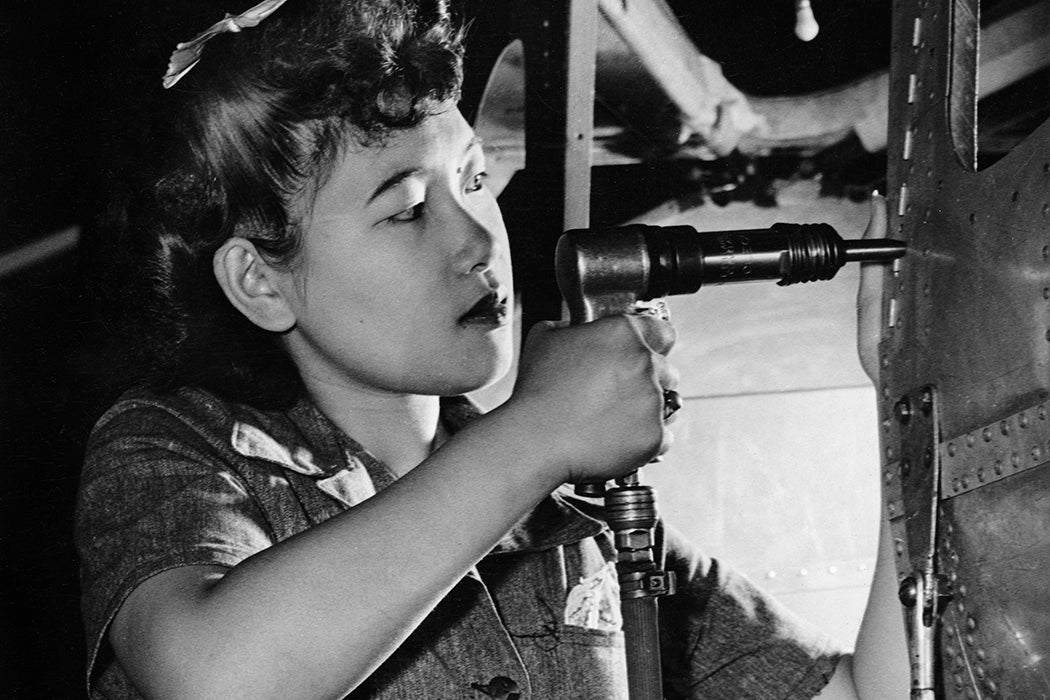Amid the social upheaval of World War II, women entered the American workforce on an unprecedented level. And, for younger Chinese American women in the San Francisco Bay Area, the war made it possible to smash not just entrenched gender barriers, but racial ones as well.
“To a large extent, the war provided an entry for Chinese American women into the larger American society, something for which their ancestors had struggled a hundred years,” writes historian Zhao Xiaojian, who argues that second-generation Chinese American women “grasped the wartime opportunity to enter the larger American society” by joining the Bay Area’s defense industry.
“Partly because of a scarcity of English-language sources on this topic, some scholars simply have assumed that Chinese American women did not share the experience of ‘Rosie the Riveter,’” she reports. But she uses newspapers, company records, and oral histories to push back on this view.
Many Chinese American women already worked out of economic necessity. Yet racial discrimination and social isolation typically restricted them to jobs in Chinatown enclaves.
“It was difficult for many Chinese American women to go outside their communities to work, even when they wanted to,” Zhao explains. “The decades-long isolation had also limited the ability of immigrant Chinese working women to communicate with the outside world.”
During the war, women were also encouraged to adopt domestic roles—preparing “nutritional food” for their families and “show[ing] our fighting men that we are… absolutely behind them.”
But World War II still marked a major turning point—especially for younger, unmarried daughters of Chinese immigrants. Many of these women had either a high school or college-level education.
“With relatively few household responsibilities, in contrast to their mothers, they had the freedom and independence to work outside the home,” Zhao writes. “Since most of them were already living in the Bay Area before the war, these younger Chinese American women were among the first American women to join the Bay Area’s defense labor force.”
In fact, Zhao’s research turned up only four women who were older than forty during their wartime jobs. Still, those wives and mothers capably juggled their duties at home and on the home front.
Some couples labored side by side. For example, Fred Yam was a pipe-fitter at the Mare Island Navy Shipyard in 1942, while his wife, a fresh high school graduate, was an electrician’s helper.
Meanwhile, middle-aged widow Ah Yoke Gee, whose high school- and college-aged children were still living with her, cooked in the mornings, and shopped and cleaned on weekends. From 1942 to 1945, California-born Ah Yoke also served as a welder in a Richmond shipyard. Her work let her be “recognized as a patriotic, hardworking defense worker” even though discriminatory laws had stripped her of her birthright citizenship when she married an immigrant from Hong Kong.
“Before the Second World War it was difficult for Chinese American women to get jobs outside Chinatown because of racial and gender discrimination,” Zhao notes. But the war prompted “an unprecedented hiring of Chinese American women in the Bay Area’s wartime industries.”
Zhao estimates that, by 1943, women made up at least one-tenth of the 5,000-odd Chinese Americans doing defense-related work in the San Francisco Bay Area.
Community newspapers like the San Francisco-based Jinshan shibao or Chinese Times also pointed to benefits of employment in the defense industry, such as subsidized housing that “provided a great opportunity for Chinese Americans to move out of their isolated ethnic ghettos.”
Indeed, wartime work put Chinese American women in close contact with Americans from other backgrounds—sometimes with life-changing consequences. For instance, Ah Yoke Gee’s daughter, Maggie, became a naval draftswoman at Mare Island after graduating from the University of California at Berkeley. There, she struck up a friendship with two other women around her age—one white, the other Filipina.
“The Filipina had taken some flying lessons before the war, and the three of them decided to save money for aviation training,” Zhao explains.
Maggie Gee ended up joining the Women’s Airforce Service Pilots, or WASPs, and spent the war transporting military supplies across the United States. After the war, she earned a doctorate and broke the glass ceiling to serve as a physicist at the Lawrence Livermore National Laboratory.
“The young Chinese American women who participated in defense work had had fresh memories of discriminatory practices in American society before the war, and they were fully aware of the political implications of taking defense jobs,” Zhao writes.
Weekly Newsletter
Racial discrimination remained a challenge in their later job searches. Still, the widespread changes wrought by the war meant their lives “were no longer restricted within their ethnic communities.”
Zhao concludes, “[W]hat they had accomplished was far more significant than the jobs themselves. They were accepted, for the first time, as Americans.”







